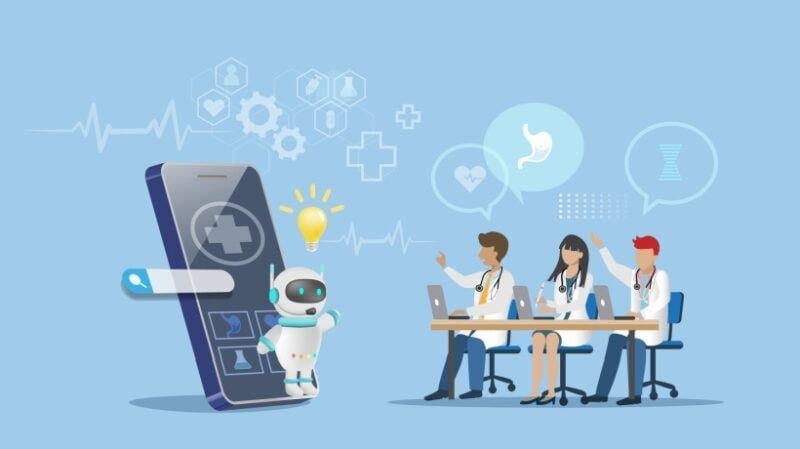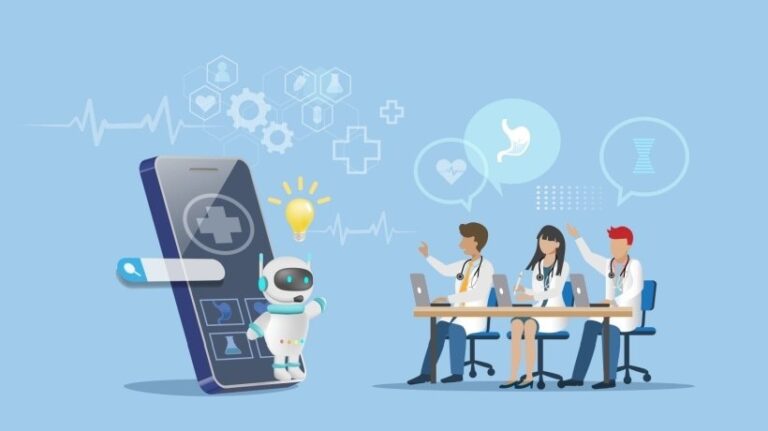
What AI in Healthcare Means for Medical Schools
Artificial intelligence (AI) is transforming nearly every part of healthcare, from diagnosis to patient management, and medical education is no exception. As the market for AI in healthcare rapidly expands, implementing AI in medical education has become essential to developing tomorrow’s healthcare professionals. Fortunately, medical schools can prepare students for an AI-driven future in healthcare by embracing technologies such as adaptive learning platforms and virtual simulations. But how exactly do AI tools support medical students and educators? And what does this look like in practice? We’ve got the answer and quite a few examples. Let’s take a closer look.
In this article…
The role of AI in medical education
AI is revolutionizing the healthcare field, and with AI in healthcare market predicted to reach more than $187 billion by 2030, it makes sense that medical schools would seek to integrate this transformative and far-reaching technology into the classroom. AI technologies in medical education include:
Clinical decision support system. Intelligent tutoring system. Automated assessment tool. Adaptive learning platform. A virtual simulation tool powered by AI.
These technologies are intended to enhance learning and provide students with the knowledge and skills necessary to provide timely, high-quality patient care. At the same time, such tools ensure that students are prepared for a workforce that is already using AI for an increasing number of tasks. Despite this, many medical schools have been slow to adopt AI. According to one study, only 14% of medical schools have developed a formal generative AI curriculum. This compares to 60% for undergraduate programs.
For medical educators to be convinced of both the value and necessity of AI in the classroom, they need evidence that AI positively impacts students and faculty. In this context, let’s take a look at the research-backed benefits of using AI in medical education.
What are the benefits of using AI in medical education?
AI provides medical students and faculty with the following benefits:
Improving the efficiency of management operations
The Time For Class 2025 report found that AI is helping professors reduce the time they spend on course-related research, grading, providing customized feedback, and communicating with students. Accelerate learning
According to a research study on medical students’ attitudes toward AI in education, 60.3% of students agreed that AI learning has optimized their learning time. Additionally, 65.7% said AI helps them understand medical concepts faster than traditional books or lectures. Support clinical decision making
Students can use AI to diagnose standardized patients and hone their decision-making skills in preparation for real-world patients. According to a survey by the American Medical Association (AMA), 12% of practicing physicians are already using AI for real-world assisted diagnosis. Medical student skills for the future
The same AMA study found that 66% of physicians are using healthcare AI. If faculty want to prepare students for the job market, they need to teach students how to take advantage of the job market effectively and ethically.
5 ways schools are using AI for medical education
Learning about the various uses of AI in medical education brings school leaders much closer to applying the technology. Here are some ways to use AI in medical schools.
1) Strengthening clinical skills
Medical students must test their clinical skills in standardized patient interactions. Here, you will create a diagnosis and treatment plan for the patient, and explain the rationale to the faculty at a subsequent debriefing session. These debriefings can be difficult for students. This is because students are required to perform a step-by-step analysis of why they arrived at a particular diagnosis.
However, AI diagnostic tools can help students better understand clinical reasoning and demystify the process. Take Dr. Cabot from Harvard Medical School, for example. This AI diagnostic system is characterized by its ability to perform differential diagnosis. The system guides students through difficult medical cases, giving them insight into how to reason their own cases, and improving their clinical skills in the process.
2) To optimize ratings and feedback
AI is also a great tool for assessing student performance and providing personalized feedback. For example, adaptive learning platforms use AI to create tests that adjust questions based on student responses. These AI-driven assessments provide valuable insights for instructors.
One such lecturer is Anastasia Lipnevich, professor of educational psychology at the City University of New York (CUNY). She said in a webinar for the American Board of Physician Examiners that AI assessments “can tell us: [a particular] For example, students make mistakes in these areas. ” and other studies show that adaptive learning platforms also provide personalized feedback to students, enhancing student engagement and knowledge retention.
3) Support for experiential learning
Rather than settling for mannequins, educators can design more immersive learning experiences by using AI simulation tools with virtual reality (VR) and augmented reality (AR) capabilities. Virtual reality uses headsets to immerse users in a computer-generated world. Augmented reality, on the other hand, brings digital elements into the user’s live view via smartphone or smart glasses.
The University of Virginia Department of Anesthesiology is leveraging previous technology by incorporating a virtual reality training platform into its curriculum. The platform allows students to interact with a digital patient using a headset and controller while following the instructions of an AI-powered virtual facilitator.
4) Strengthening curriculum development
AI can modernize traditional medical education by leveraging analytics to inform the curriculum. For example, machine learning models can analyze student performance data and provide recommendations on how to tailor course content to meet learner needs. AI can also help generate course materials.
At the University of Miami Miller School of Medicine, faculty used generative AI to create “a large library of simulated patient cases” and fact-check them for errors and bias. This provides medical students with a greater variety of examples than those found in traditional textbooks and prepares them for the different types of patients they will encounter in a real hospital.
5) Expand your research efforts
Students and faculty can use AI to conduct groundbreaking research that ultimately leads to new treatments and technologies that improve quality of life. Take a look at Yale University School of Medicine. The school is home to the Yale Hematology Tissue Bank, which provides researchers with patient samples for the study of blood diseases.
Yale faculty built a large-scale hematology-specific language model to speed up the process of extracting clinical information from these samples. The faculty hope to use this model to build a hematology research database that researchers can search using natural language questions. According to one of the researchers who helped build the large-scale language model, the AI tool’s goal is to “facilitate biomedical research to improve care for patients with blood disorders.”
Ethical considerations for AI in medical education
The use of AI in medical education raises several ethical issues, including:
Privacy and data security
AI must handle sensitive student and, in some cases, patient information. Without proper safeguards, such data becomes vulnerable to breaches. bias and fairness
A research article published in The Milbank Quarterly found that AI algorithms can exhibit biases that can harm Black patients. So, for example, a student who uses a biased AI algorithm to help diagnose a standardized patient may misdiagnose a patient from this racial/ethnic group. Transparency and explainability
Students and faculty need to understand how AI makes diagnostic and treatment decisions. Otherwise, a lack of transparency and readability will hinder the effective and ethical implementation of AI technologies. Human expertise and supervision
AI must be used to support, not replace, human skill and judgment. Over-reliance on AI in clinical reasoning, curriculum development, assessment, and other aspects of medical education will undermine the critical thinking and decision-making skills of students and faculty.
Medical schools should develop clear guidelines to address all these ethical concerns. They should also provide policies for the appropriate use of AI, based on insights from educators, students, ethicists, researchers, and policy makers.
School leaders can look to other medical schools to inform their policies. For example, dozens of schools have published AI guidelines online, including Harvard Medical School, the University at Buffalo Jacobs School of Medicine and Biomedical Sciences, and Boston University Chobanian & Avedisyan School of Medicine.
The future of medical education is human-centered and AI-supported
AI has the potential to enhance medical education, and based on the examples we have seen, it is already doing so. Students use it as a learning tool and to enhance their clinical skills. Meanwhile, teachers are leveraging technology for assessment and curriculum development. That said, medical schools should provide clear and comprehensive AI policies to guide student and faculty use. This ensures that usage is not overly dependent and that human expertise remains at the forefront, similar to a real hospital or clinic. The future of healthcare may be aided by AI, but it will always be human-centric. Therefore, medical schools must uphold this philosophy as a means for students to pursue a career in the medical industry.


